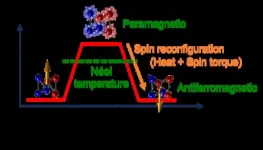(Press-News.org) Saskatchewan education sector workers are experiencing disturbing levels of workplace violence and harassment, says a new report spotlighting a situation that has reached “a breaking point,” according to its authors.
Testimonies catalogued by University of Ottawa researchers found Saskatchewan schools are far from offering a safe and violence-free environment as workplace violence becomes increasingly normalized.
“I’ve been punched in the face, had push pins held to my eyeballs, and scissors held to my throat,” the report quotes one educational assistant. “(A) student flipped a table, choked me with my lanyard, and repeatedly threw the chair into the wall … (then) the window and started kicking (me),” assert some of the people interviewed for the study.
The findings
Researchers surveyed 828 Saskatchewan education sector workers –teachers as well as direct and indirect student support workers – for the National Violence and Harassment Against Education Sector Workers surveynorth_eastexternal link, and found:
Nearly three-quarters of respondents experienced one attempt of physical force from a student.
85% witnessed at least one student-initiated act, attempt, or threat of physical force against a co-worker. These behaviours frequently involved a refusal to respect authority, swearing, and offensive remarks.
54% of respondents experienced parent-initiated harassment, with teachers and clerical workers reporting the highest rates.
Women experienced 20 unique acts, attempts, or threats of physical force from a student, whereas men reported an average of 10.
Identity plays a role: education sector workers with a reported diagnosed mental illness were most often targeted for harassment, as were 2SLGBTQIA+ workers.
“Saskatchewan schools are beyond the breaking point. Years of underfunding and dwindling resources have culminated in compounding costs and everyone in the school community is paying the price,” says Chris Bruckert, a Full Professor from the Faculty of Social Sciences at the University of Ottawa and Principal Investigator on the project.
Impact on students
The lead author, Darby Mallory, a uOttawa doctoral student in the Department of Criminology noted: “It is hard to overstate how destabilizing it is for students to routinely witness violence against their teachers and/or educational assistants. The research identified three principal ways students are affected by educator-directed violence: access to instruction, capacity to learn, and emotional well-being.”
The detailed report found just 6% of respondents felt actions taken to deal with the violence they experienced were ‘very effective’. Most institutional responses to workplace violence and harassment were reactive, deflective, or dismissive, with participants describing their concerns being negated as incidents are routinely “swept under the rug.”
Proactive measures like safety plans have the potential to address these issues but their effectiveness is compromised by the chronic lack of resources in schools.
“Overwhelmingly, Saskatchewan’s education sector workers described feeling burnt out, less enthusiastic, and dissatisfied with their jobs,” adds Bruckert from the Department of Criminology. “We all pay the price when careers are abandoned by trained education sector workers, and the physical and mental injuries at work further strain our healthcare system.”
‘Beyond the Breaking Point: Violence against Saskatchewan’s Education Sector Workers’ by Darby Mallory, Chris Bruckert, Hanya Ismail, and Darcy Santor was published on September 24, 2024.
END
Violence, harassment from students is overwhelmingly ‘part of the job’ for Saskatchewan education sector workers
Saskatchewan education sector workers are experiencing disturbing levels of workplace violence and harassment, says a new report spotlighting a situation that has reached “a breaking point,” according to its authors.
2024-09-24
ELSE PRESS RELEASES FROM THIS DATE:
Thermal effects in spintronics systematically assessed for first time
2024-09-24
Spintronics – devices that use microscopic magnetism in conjunction with electric current – could lead to computing technology as fast as conventional electronics but much more energy efficient. As such devices are developed and studied, an important unresolved question is how device operation is affected by heating.
A new experimental technique, reported by researchers at the University of Illinois Urbana-Champaign in the journal APL Materials, directly measures heating in spintronic devices, allowing direct comparison to other effects. The researchers say that this technique can be used to select spintronic materials whose magnetic behavior is minimally impacted by heating, ...
Study shows rates of e-bike injuries rise fourfold and powered scooter injuries nearly double
2024-09-24
September 24, 2024-- The rate of e-bike and powered scooter injuries surged between 2019 and 2022-- by 293 percent and 88 percent, respectively, according to a new study at Columbia University Mailman School of Public Health. The research adds to the existing information and gap in knowledge on the sociodemographic and risk factor variables that might be contributing to micromobility vehicle–related injuries. The findings are published in the American Journal of Public Health.
Micromobility generally refers to any small, low-speed, human- or electric-powered transportation device. Between 2019 and 2022, e-bike sales increased by 269 ...
Prediabetes during adolescence and young adulthood linked with likelihood of adverse pregnancy outcomes
2024-09-24
September 24, 2024-- New research conducted at Columbia Mailman School of Public Health and Mount Sinai School of Medicine shows a link between prediabetes among young people and adverse pregnancy outcomes later in life. The findings could alter how doctors routinely screen or counsel youth on blood glucose levels, and subsequently, minimize potential maternal and neonatal risks. The results are published in JAMA Network Open.
“This study is an important step in tying lifecourse cardiometabolic health to optimal pregnancy outcomes,” said Teresa Janevic, PhD, associate professor of Epidemiology at Columbia University Mailman School of Public Health and senior author. ...
Researchers discover new role of immune cells in eye health
2024-09-24
The eye is an immune-privileged tissue because of the need to keep blood vessels away from the central pathway of light and to restrict entry of inflammatory cells that could cause damage. This has prompted questions about how the eye manages inflammation when it occurs.
A new study led by Thomas Jefferson University researchers has revealed insights into how the eye handles inflammation, particularly in autoimmune uveitis, an inflammatory disease that bypasses the eye’s immune privilege and can damage healthy eye tissue.
Previous studies by Jefferson researcher Sue Menko, PhD, revealed that immune cells ...
Daniel R. Larson to receive 2025 Carolyn Cohen Innovation Award
2024-09-24
ROCKVILLE, MD – The Biophysical Society is pleased to announce that Daniel R. Larson, PhD, of the Center for Cancer Research at the National Cancer Institute within the National Institutes of Health, will receive the 2025 Carolyn Cohen Innovation Award. Larson will be honored at the Society’s 69th Annual Meeting, being held in Los Angeles, California from February 15-19, 2025.
Larson is being recognized for his pioneering contributions to the field of gene regulation using single-cell and single-molecule biophysical ...
James A. Glazier to receive 2025 Klaus Schulten and Zaida Luthey-Schulten Computational Biophysics Lecture Award
2024-09-24
ROCKVILLE, MD – The Biophysical Society is pleased to announce that James A. Glazier, PhD, of Indiana University, Bloomington, has been named the recipient of the 2025 Klaus Schulten and Zaida Luthey-Schulten Computational Biophysics Lecture Award. Glazier will be honored at the Society’s 69th Annual Meeting, being held in Los Angeles, California from February 15-19, 2025.
Glazier will be recognized for his development of algorithms, software, and models describing the emergent multicellular organization of development, homeostasis, and disease.
“I am delighted that the Biophysical Society is recognizing James’s pioneering work the ...
Better together: Gut microbiome communities’ resilience to drugs
2024-09-24
Many human medications can directly inhibit the growth and alter the function of the bacteria that constitute our gut microbiome. EMBL Heidelberg researchers have now discovered that this effect is reduced when bacteria form communities.
In a first-of-its-kind study, researchers from EMBL Heidelberg's Typas, Bork, Zimmermann, and Savitski groups, and many EMBL alumni, including Kiran Patil (MRC Toxicology Unit Cambridge, UK), Sarela Garcia-Santamarina (ITQB, Portugal), André Mateus (Umeå University, ...
More to munch on: The popcorn planet WASP-107b unveils new atmospheric details
2024-09-24
The "popcorn planet" is back in the spotlight! Using NASA's James Webb Space Telescope (JWST), a team of international astronomers has discovered new atmospheric details on WASP-107b, an exoplanet with a puffed-up atmosphere due to tidal heating. Previously described as an extremely low-density "popcorn planet" by researchers, WASP-107b has once again proven to be an intriguing subject, revealing even more surprising characteristics about its inflated and dynamic atmosphere.
WASP-107b, a gas giant about the size of Jupiter but with just one-tenth of its mass, has ...
Innovative electrolytes could transform steelmaking and beyond
2024-09-24
The lifeblood of any battery is the electrolyte. It is the medium through which positively charged elements (cations) migrate en masse between the positive and negative electrodes. By this means, batteries discharge to provide energy and charge to store energy. Scientists call this an electrochemical process.
Electrolytes are central to the development of different electrochemical processes, as well. For example, they could be used in converting iron ore into purified iron metal or iron alloys. A challenge is that the electrolyte must remain stable under extreme operating conditions and avoid side reactions that reduce energy efficiency. The payoff ...
Planting seeds for safer farming
2024-09-24
Per- and polyfluoroalkyl substances (PFAS) are human-made chemicals that were introduced in the 1940s. PFAS are used to create a variety of products including water-resistant clothing, non-stick cookware, and firefighting foams.
Unfortunately, PFAS can have negative effects on health, including increases in cholesterol levels and changes to liver function. Using PFAS-containing products can lead to their presence in the treated wastewater and treated sludge (referred to as biosolids). When grown on biosolid-amended farmland soils or irrigated with treated wastewater, crops can bioaccumulate PFAS. The PFAS-accumulated crops can be consumed directly by the public or indirectly ...
LAST 30 PRESS RELEASES:
Eye for trouble: Automated counting for chromosome issues under the microscope
The vast majority of US rivers lack any protections from human activities, new research finds
Ultrasound-responsive in situ antigen "nanocatchers" open a new paradigm for personalized tumor immunotherapy
Environmental “superbugs” in our rivers and soils: new one health review warns of growing antimicrobial resistance crisis
Triple threat in greenhouse farming: how heavy metals, microplastics, and antibiotic resistance genes unite to challenge sustainable food production
Earthworms turn manure into a powerful tool against antibiotic resistance
AI turns water into an early warning network for hidden biological pollutants
Hidden hotspots on “green” plastics: biodegradable and conventional plastics shape very different antibiotic resistance risks in river microbiomes
Engineered biochar enzyme system clears toxic phenolic acids and restores pepper seed germination in continuous cropping soils
Retail therapy fail? Online shopping linked to stress, says study
How well-meaning allies can increase stress for marginalized people
Commercially viable biomanufacturing: designer yeast turns sugar into lucrative chemical 3-HP
Control valve discovered in gut’s plumbing system
George Mason University leads phase 2 clinical trial for pill to help maintain weight loss after GLP-1s
Hop to it: research from Shedd Aquarium tracks conch movement to set new conservation guidance
Weight loss drugs and bariatric surgery improve the body’s fat ‘balance:’ study
The Age of Fishes began with mass death
TB harnesses part of immune defense system to cause infection
Important new source of oxidation in the atmosphere found
A tug-of-war explains a decades-old question about how bacteria swim
Strengthened immune defense against cancer
Engineering the development of the pancreas
The Journal of Nuclear Medicine ahead-of-print tip sheet: Jan. 9, 2026
Mount Sinai researchers help create largest immune cell atlas of bone marrow in multiple myeloma patients
Why it is so hard to get started on an unpleasant task: Scientists identify a “motivation brake”
Body composition changes after bariatric surgery or treatment with GLP-1 receptor agonists
Targeted regulation of abortion providers laws and pregnancies conceived through fertility treatment
Press registration is now open for the 2026 ACMG Annual Clinical Genetics Meeting
Understanding sex-based differences and the role of bone morphogenetic protein signaling in Alzheimer’s disease
Breakthrough in thin-film electrolytes pushes solid oxide fuel cells forward
[Press-News.org] Violence, harassment from students is overwhelmingly ‘part of the job’ for Saskatchewan education sector workersSaskatchewan education sector workers are experiencing disturbing levels of workplace violence and harassment, says a new report spotlighting a situation that has reached “a breaking point,” according to its authors.


